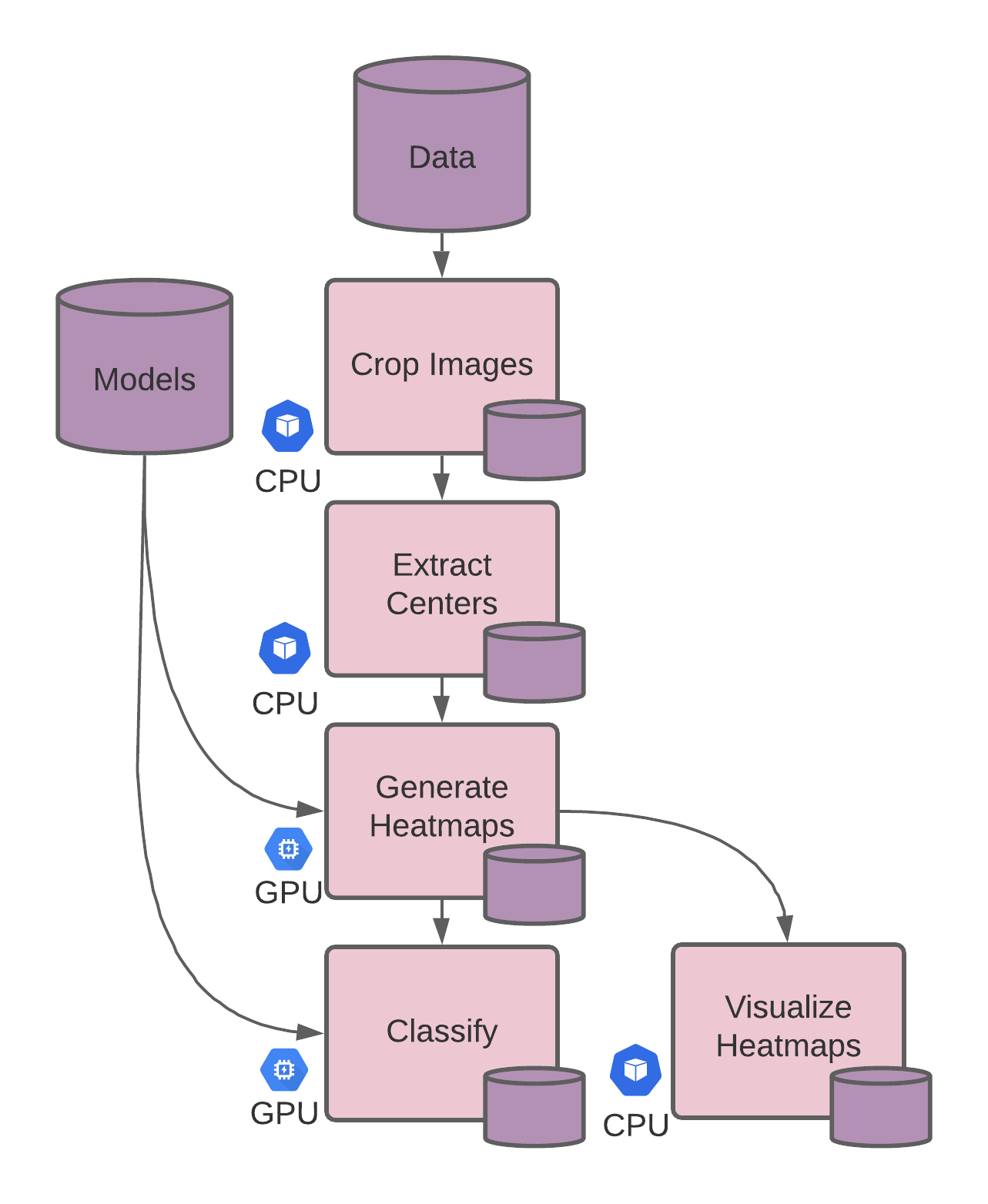Task Parallelism Pipeline
Learn how to build a scalable inference pipeline using task parallelism.
In this tutorial, we’ll build a scalable inference pipeline for breast cancer detection using task parallelism.
Before You Start #
- You must have a Pachyderm cluster up and running
- You should have some basic familiarity with Pachyderm pipeline specs – see the Transform, Join Input, Resource Limits, Resource Requests, and Parallelism sections in particular
Tutorial #
Our Docker image’s user code for this tutorial is built on top of the pytorch/pytorch base image, which includes necessary dependencies. The underlying code and pre-trained breast cancer detection model comes from this repo, developed by the Center of Data Science and Department of Radiology at NYU. Their original paper can be found here.
1. Create an Input Repo #
Make sure your Tutorials project we created in the Standard ML Pipeline tutorial is set to your active context. (This would only change if you have updated your active context since completing the first tutorial.)
pachctl config get context localhost:80 # { # "pachd_address": "grpc://localhost:80", # "cluster_deployment_id": "KhpCZx7c8prdB268SnmXjELG27JDCaji", # "project": "Tutorials" # }Create the following repos:
pachctl create repo models pachctl create repo sample_data
2. Create CPU Pipelines #
In task parallelism, we separate out the CPU-based preprocessing and GPU-related tasks, saving us cloud costs when scaling. By separating inference into multiple tasks, each task pipeline can be updated independently, allowing ease of model deployment and collaboration.
We can split the run.sh script used in the previous tutorial (Data Parallelism Pipeline) into 5 separate processing steps (4 already defined in the script + a visualization step) which will become Pachyderm pipelines, so each can be scaled separately.

Crop Pipeline #
- Create a file named
crop.jsonwith the following contents:
{
"pipeline": {
"name": "crop"
},
"description": "Remove background of image and save cropped files.",
"input": {
"pfs": {
"repo": "sample_data",
"glob": "/*"
}
},
"transform": {
"cmd": [
"/bin/bash",
"multi-stage/crop.sh"
],
"image": "pachyderm/breast_cancer_classifier:1.11.6"
}
}- Save the file.
- Create the pipeline.
pachctl create pipeline -f /path/to/crop.jsonExtract Centers Pipeline #
- Create a file named
extract_centers.jsonwith the following contents:
{
"pipeline": {
"name": "extract_centers"
},
"description": "Compute and Extract Optimal Image Centers.",
"input": {
"pfs": {
"repo": "crop",
"glob": "/*"
}
},
"transform": {
"cmd": [
"/bin/bash",
"multi-stage/extract_centers.sh"
],
"image": "pachyderm/breast_cancer_classifier:1.11.6"
}
}- Save the file.
- Create the pipeline.
pachctl create pipeline -f /path/to/extract_centers.json3. Create GPU Pipelines #
Generate Heatmaps Pipeline #
- Create a file named
generate_heatmaps.jsonwith the following contents:
{
"pipeline": {
"name": "generate_heatmaps"
},
"description": "Generates benign and malignant heatmaps for cropped images using patch classifier.",
"input": {
"cross": [
{
"join": [
{
"pfs": {
"repo": "crop",
"glob": "/(*)",
"join_on": "$1",
"lazy": false
}
},
{
"pfs": {
"repo": "extract_centers",
"glob": "/(*)",
"join_on": "$1",
"lazy": false
}
}
]
},
{
"pfs": {
"repo": "models",
"glob": "/",
"lazy": false
}
}
]
},
"transform": {
"cmd": [
"/bin/bash",
"multi-stage/generate_heatmaps.sh"
],
"image": "pachyderm/breast_cancer_classifier:1.11.6"
},
"resource_limits": {
"gpu": {
"type": "nvidia.com/gpu",
"number": 1
}
},
"resource_requests": {
"memory": "4G",
"cpu": 1
}
}- Save the file.
- Create the pipeline.
pachctl create pipeline -f /path/to/generate_heatmaps.jsonClassify Pipeline #
- Create a file named
classify.jsonwith the following contents:
{
"pipeline": {
"name": "classify"
},
"description": "Runs the image only model and image+heatmaps model for breast cancer prediction.",
"input": {
"cross": [
{
"join": [
{
"pfs": {
"repo": "crop",
"glob": "/(*)",
"join_on": "$1"
}
},
{
"pfs": {
"repo": "extract_centers",
"glob": "/(*)",
"join_on": "$1"
}
},
{
"pfs": {
"repo": "generate_heatmaps",
"glob": "/(*)",
"join_on": "$1"
}
}
]
},
{
"pfs": {
"repo": "models",
"glob": "/"
}
}
]
},
"transform": {
"cmd": [
"/bin/bash",
"multi-stage/classify.sh"
],
"image": "pachyderm/breast_cancer_classifier:1.11.6"
},
"resource_limits": {
"gpu": {
"type": "nvidia.com/gpu",
"number": 1
}
},
"resource_requests": {
"memory": "4G",
"cpu": 1
}
}- Save the file.
- Create the pipeline
pachctl create pipeline -f /path/to/classify.json
4. Upload Dataset #
- Open or download this github repo.
gh repo clone pachyderm/docs-content - Navigate to this tutorial.
cd content/2.7.x/build-dags/tutorials/task-parallelism - Upload the
sample_dataandmodelsfolders to your repos.pachctl put file -r sample_data@master -f sample_data/ pachctl put file -r models@master -f models/
User Code Assets #
The Docker image used in this tutorial was built with the following assets:
FROM pytorch/pytorch:1.7.1-cuda11.0-cudnn8-devel
# Update NVIDIA's apt-key
# Announcement: https://forums.developer.nvidia.com/t/notice-cuda-linux-repository-key-rotation/212772
ENV DISTRO ubuntu1804
ENV CPU_ARCH x86_64
RUN apt-key adv --fetch-keys https://developer.download.nvidia.com/compute/cuda/repos/$DISTRO/$CPU_ARCH/3bf863cc.pub
RUN apt-get update && apt-get install -y git libgl1-mesa-glx libglib2.0-0
WORKDIR /workspace
RUN git clone https://github.com/jimmywhitaker/breast_cancer_classifier.git /workspace
RUN pip install --upgrade pip && pip install -r requirements.txt
RUN pip install matplotlib --ignore-installed
RUN apt-get -y install tree
COPY . /workspace#!/bin/bash
NUM_PROCESSES=10
ID=$(ls /pfs/sample_data/ | head -n 1)
DATA_FOLDER="/pfs/sample_data/${ID}/"
INITIAL_EXAM_LIST_PATH="/pfs/sample_data/${ID}/gen_exam_list_before_cropping.pkl"
CROPPED_IMAGE_PATH="/pfs/out/${ID}/cropped_images"
CROPPED_EXAM_LIST_PATH="/pfs/out/${ID}/cropped_images/cropped_exam_list.pkl"
EXAM_LIST_PATH="/pfs/out/${ID}/data.pkl"
export PYTHONPATH=$(pwd):$PYTHONPATH
echo 'Stage 1: Crop Mammograms'
python3 src/cropping/crop_mammogram.py \
--input-data-folder $DATA_FOLDER \
--output-data-folder $CROPPED_IMAGE_PATH \
--exam-list-path $INITIAL_EXAM_LIST_PATH \
--cropped-exam-list-path $CROPPED_EXAM_LIST_PATH \
--num-processes $NUM_PROCESSES#!/bin/bash
DEVICE_TYPE='gpu'
NUM_EPOCHS=10
HEATMAP_BATCH_SIZE=100
GPU_NUMBER=0
ID=$(ls /pfs/crop/ | head -n 1)
IMAGEHEATMAPS_MODEL_PATH="/pfs/models/sample_imageheatmaps_model.p"
CROPPED_IMAGE_PATH="/pfs/crop/${ID}/cropped_images"
EXAM_LIST_PATH="/pfs/extract_centers/${ID}/data.pkl"
HEATMAPS_PATH="/pfs/generate_heatmaps/${ID}/heatmaps"
IMAGEHEATMAPS_PREDICTIONS_PATH="/pfs/out/${ID}/imageheatmaps_predictions.csv"
export PYTHONPATH=$(pwd):$PYTHONPATH
echo 'Stage 4b: Run Classifier (Image+Heatmaps)'
python3 src/modeling/run_model.py \
--model-path $IMAGEHEATMAPS_MODEL_PATH \
--data-path $EXAM_LIST_PATH \
--image-path $CROPPED_IMAGE_PATH \
--output-path $IMAGEHEATMAPS_PREDICTIONS_PATH \
--use-heatmaps \
--heatmaps-path $HEATMAPS_PATH \
--use-augmentation \
--num-epochs $NUM_EPOCHS \
--device-type $DEVICE_TYPE \
--gpu-number $GPU_NUMBER#!/bin/bash
NUM_PROCESSES=10
ID=$(ls /pfs/crop/ | head -n 1)
CROPPED_IMAGE_PATH="/pfs/crop/${ID}/cropped_images"
CROPPED_EXAM_LIST_PATH="/pfs/crop/${ID}/cropped_images/cropped_exam_list.pkl"
EXAM_LIST_PATH="/pfs/out/${ID}/data.pkl"
export PYTHONPATH=$(pwd):$PYTHONPATH
echo 'Stage 2: Extract Centers'
python3 src/optimal_centers/get_optimal_centers.py \
--cropped-exam-list-path $CROPPED_EXAM_LIST_PATH \
--data-prefix $CROPPED_IMAGE_PATH \
--output-exam-list-path $EXAM_LIST_PATH \
--num-processes $NUM_PROCESSES#!/bin/bash
DEVICE_TYPE='gpu'
HEATMAP_BATCH_SIZE=100
GPU_NUMBER=0
ID=$(ls /pfs/crop/ | head -n 1)
PATCH_MODEL_PATH="/pfs/models/sample_patch_model.p"
CROPPED_IMAGE_PATH="/pfs/crop/${ID}/cropped_images"
EXAM_LIST_PATH="/pfs/extract_centers/${ID}/data.pkl"
HEATMAPS_PATH="/pfs/out/${ID}/heatmaps"
export PYTHONPATH=$(pwd):$PYTHONPATH
echo 'Stage 3: Generate Heatmaps'
python3 src/heatmaps/run_producer.py \
--model-path $PATCH_MODEL_PATH \
--data-path $EXAM_LIST_PATH \
--image-path $CROPPED_IMAGE_PATH \
--batch-size $HEATMAP_BATCH_SIZE \
--output-heatmap-path $HEATMAPS_PATH \
--device-type $DEVICE_TYPE \
--gpu-number $GPU_NUMBER#!/bin/bash
ID=$(ls /pfs/crop/ | head -n 1)
CROPPED_IMAGE_PATH="/pfs/crop/${ID}/cropped_images/"
HEATMAPS_PATH="/pfs/generate_heatmaps/${ID}/heatmaps/"
OUTPUT_PATH="/pfs/out/${ID}/"
export PYTHONPATH=$(pwd):$PYTHONPATH
echo 'Stage 5: Visualize Heatmaps'
python3 src/heatmaps/visualize_heatmaps.py \
--image-path $CROPPED_IMAGE_PATH \
--heatmap-path $HEATMAPS_PATH \
--output-path $OUTPUT_PATH 
